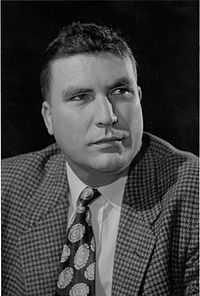Herbert York
Herbert York | |
|---|---|
 Herbert F. York in 1957 | |
| Born | 24 November 1921 Rochester, New York, USA |
| Died | 19 May 2009 (aged 87) |
| Nationality | United States |
| Alma mater | University of Rochester (B.S., M.S.) (1943) University of California, Berkeley (Ph.D) (1949) |
| Awards | E. O. Lawrence Award (1962) Enrico Fermi Award (2000) Vannevar Bush Award (2000) Clark Kerr Medal (2000)[1] |
| Scientific career | |
| Fields | Nuclear Physics |
| Institutions | University of California Radiation Laboratory Manhattan Project Lawrence Livermore National Laboratory University of California, Berkeley University of California San Diego Advanced Research Projects Agency (DARPA) Defense Department Research and Engineering (DDR&E) |
Herbert Frank York (24 November 1921 – 19 May 2009) was a part-Mohawk[2] American nuclear physicist. He held numerous research and administrative positions at various United States government and educational institutes.
Biography
York was born in Rochester, New York where he received his B.S. and M.S. from the University of Rochester in 1943, and went on to obtain his Ph.D. from the University of California, Berkeley in 1949.[3] During World War II he was a physicist at the Berkeley Radiation Laboratory and at Oak Ridge, Tennessee as part of the Manhattan Project. He was the first director of Lawrence Livermore National Laboratory from 1952 to 1958. After leaving the laboratory in 1958, he held numerous positions in both government and academia, including the first Chief Scientist of the Advanced Research Projects Agency, and the first Director of Defense Research and Engineering.
York was a professor of physics at the University of California, Berkeley. He was the founding Chancellor of the University of California San Diego (1961–1964, 1970–1972). He later served as U.S. ambassador to the Comprehensive Test Ban negotiations in Geneva, Switzerland (1979–1981).[4]
York was Director Emeritus of the Institute on Global Conflict and Cooperation at UC San Diego and served as chairman of the university's Scientific and Academic Advisory Committee, which oversees activities at both Livermore and Los Alamos National Laboratories. He also served on the board of the Council for a Livable World, a nonpartisan arms control organization in Washington, D.C. York occasionally guest lectured for UC San Diego and other institutions.
Herbert York died 19 May 2009 in San Diego at age 87.[5]
Publications
- Race to Oblivion (Simon & Schuster, 1970)[6]
- Arms Control (Readings from Scientific American (W.H. Freeman, 1973)
- The Advisors: Oppenheimer, Teller and the Superbomb (W.H. Freeman, 1976), a book that Hans Bethe regarded as containing a highly accurate treatment of the "Russian H-bomb" test of 1953.[7]
- Autobiography (1978). "Race to Oblivion: A Participant's View of the Arms Race". Simon and Schuster. Retrieved 2008-10-23.
{{cite web}}: External link in|last= - Making Weapons, Talking Peace: A Physicist's Journey from Hiroshima to Geneva (Harper & Row, 1987)
- A Shield in Space? Technology, Politics and the Strategic Defense Initiative (U.C. Press, 1988, with Sanford Lakoff)
- Arms and the Physicist (American Physical Society, 1994)
References
- ^ https://str.llnl.gov/Sep09/trost.html
- ^ http://www.edge.org/conversation/nsa-the-decision-problem. The Decision Problem
- ^ "Biographies: Herbert York (b. 1921 d. May 19, 2009)". The Atomic Archive. National Science Digital Library. 2008. Retrieved 2008-11-30.
- ^ Tiersten, Sylvia (January 2009). "Herbert F. York, UC San Diego's first Chancellor". @UCSD.
{{cite journal}}: Cite journal requires|journal=(help) - ^ Grimes, William (May 25, 2009). "Herbert York, 87, Top Nuclear Physicist Who Was Arms Control Advocate, Dies". The New York Times.
- ^ http://www.learnworld.com/ZNW/LWText.York.Race.Access.html Race to Oblivion
- ^ Comments on The History of the H-Bomb LA-UR-82-5215
External links
- Annotated Bibliography for Herbert York from the Alsos Digital Library for Nuclear Issues
- Interview: Conversations with History: Reminiscences from a Career in Science, National Security, and the University, with Herbert F. York
- Herbert F. York Papers MSS 107. Special Collections & Archives, UC San Diego Library.
- 1921 births
- 2009 deaths
- American nuclear physicists
- Chancellors of the University of California, San Diego
- Enrico Fermi Award recipients
- Manhattan Project people
- Oak Ridge National Laboratory people
- Lawrence Livermore National Laboratory staff
- United States Department of Defense officials
- University of Rochester alumni
- University of California, Berkeley alumni
- University of California, Berkeley faculty
- People from Rochester, New York
- Vannevar Bush Award recipients
- Guggenheim Fellows
